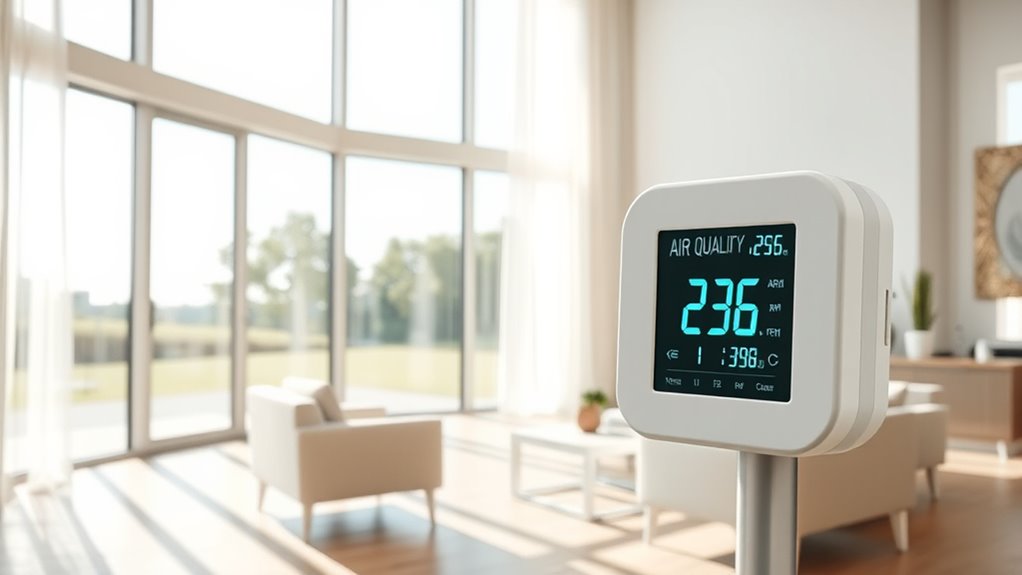To calculate ACH for a room, I start by measuring the room’s length, width, and height to find its volume in cubic feet. Then, I find the airflow rate in CFM from the ventilation system. I use the formula ACH = (CFM × 60) divided by the room volume. If you want to understand how to optimize your space’s air quality, keeping these steps in mind will help you learn more.
Key Takeaways
- Measure room dimensions (length, width, height) accurately to calculate volume in cubic feet.
- Obtain the airflow rate (CFM) from your ventilation system or HVAC specifications.
- Use the formula ACH = (CFM × 60) / room volume to determine air changes per hour.
- Ensure your calculated ACH meets recommended standards for your space type (e.g., 4-6 for offices).
- Regularly monitor and adjust ventilation to maintain adequate ACH for air quality and safety.

Have you ever wondered how often the air inside a room is refreshed? It’s a question that ties directly into ventilation standards and indoor air quality. The truth is, proper ventilation isn’t just about comfort; it’s about health, safety, and ensuring the air we breathe stays clean and fresh. Knowing how to calculate air changes per hour (ACH) is essential if you want to maintain good indoor air quality, especially in spaces where people spend a lot of time or where pollutants can accumulate.
ACH measures how many times the air within a room is replaced in one hour. It’s a key metric that helps determine whether a space is ventilated adequately. To calculate ACH, you need two main pieces of data: the airflow rate, usually measured in cubic feet per minute (CFM), and the volume of the room in cubic feet. The formula is straightforward: ACH equals the airflow rate divided by the room volume, then multiplied by 60 to convert minutes to hours. So, ACH = (CFM × 60) / Room Volume (cubic feet). This calculation gives you a clear number to evaluate whether your ventilation meets recommended standards.
ACH indicates how many times indoor air is refreshed hourly, ensuring proper ventilation and air quality.
Ventilation standards vary depending on the type of space and its use. For instance, offices and residential rooms often require a lower ACH, around 4-6 exchanges per hour, while hospitals or laboratories might need 12 or more. These standards are set to optimize indoor air quality by ensuring enough fresh air circulates to dilute indoor pollutants, allergens, and pathogens. When ACH is too low, stale air lingers, and indoor air quality suffers, leading to discomfort, health issues, and even increased transmission of airborne illnesses.
Calculating ACH is a practical way to assess whether your space meets these ventilation standards. First, measure your room’s dimensions accurately—length, width, and height—to determine its volume. Next, find out the airflow rate from your ventilation system, which might be available on the equipment specifications or from an HVAC professional. Plug these numbers into the formula, and you’ll see whether your ventilation setup is sufficient. If it’s below recommended levels, increasing airflow or improving ventilation methods can make a huge difference in indoor air quality.
Understanding ACH isn’t just for HVAC professionals; it’s a crucial tool for anyone concerned about creating a healthy indoor environment. By regularly calculating and monitoring ACH, you can ensure your space stays well-ventilated, comfortable, and safe for everyone inside. Additionally, proper ventilation techniques can significantly improve overall indoor air quality and reduce the risk of airborne illnesses.
Frequently Asked Questions
How Does ACH Impact Indoor Air Quality?
ACH directly impacts indoor air quality by ensuring proper ventilation standards and effective air circulation. When ACH is high, fresh air replaces stale air more frequently, reducing pollutants and allergens. This helps maintain a healthier environment, especially in crowded or sealed spaces. I focus on achieving the right ACH to improve air quality, making sure ventilation standards are met for comfort and health.
What Is the Ideal ACH for Residential Spaces?
Think of ACH as the heartbeat of a healthy home. For residential spaces, I recommend aiming for 3 to 6 ACH, aligning with ventilation standards that promote fresh air and effective air purification. This range keeps indoor air clean, reduces pollutants, and guarantees comfort. Maintaining this balance helps your home breathe easier and supports your well-being, making your living environment safer and more enjoyable for everyone inside.
How Often Should HVAC Filters Be Replaced Based on ACH?
I recommend replacing HVAC filters every 1 to 3 months, depending on your home’s ventilation standards and filter type. If your ACH is high or you have allergies, more frequent changes are best. Regular filter replacement guarantees proper airflow, maintains indoor air quality, and keeps your HVAC system running efficiently. Always follow your manufacturer’s guidelines and consider your specific ventilation needs for ideal air quality.
Can ACH Calculations Improve Energy Efficiency?
Imagine your home as a well-orchestrated symphony where ventilation standards set the tempo. Yes, ACH calculations can boost energy efficiency by fine-tuning air exchange rates, preventing over-ventilation and reducing energy waste. When I optimize ACH, I ensure your HVAC system works smarter, not harder, conserving power while maintaining healthy air quality. It’s like giving your home a gust of fresh, efficient air every time.
How Does Room Shape Affect ACH Measurement Accuracy?
Room shape substantially impacts ACH measurement accuracy because ventilation efficiency varies with geometry. I find that irregular or complex room shapes can create airflow dead zones, making ACH estimates less reliable. To improve accuracy, I consider room geometry when designing ventilation systems or measuring air exchange. Understanding how ventilation efficiency changes with room shape helps me guarantee proper air quality and energy use, especially in spaces with unique or challenging layouts.
Conclusion
Now that you know how to calculate air changes per hour, you’re armed with a powerful tool to improve your space’s air quality. Think of ACH as the heartbeat of a healthy room—pulsing life and freshness into every corner. By mastering this simple calculation, you’re not just managing air; you’re creating a safer, more comfortable environment. So, why leave your air quality to chance when you can control the rhythm of your own breathing space?








